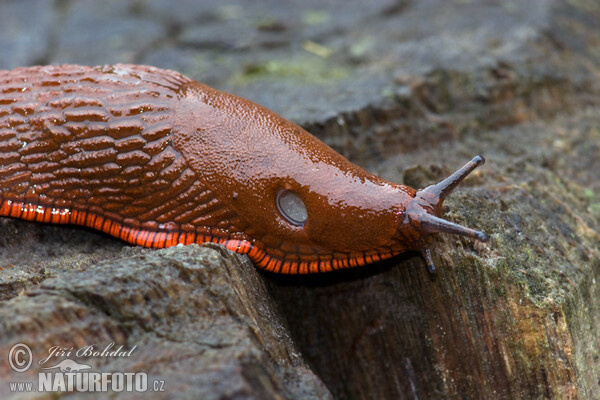Giant Killer Slugs: A Real Life Horror Movie
http://www.theguardian.com/environment/2013/oct/12/invasion-killer-slugs-you-can-help
Giant Killer Slugs? It sounds like some low
budget horror movie, but in reality, invasion of Spanish slugs is becoming an issue
in Britain. In the article titled “Can science stop invasion of the giant
killer slugs?” written by Robin McKie for The Guardian, published October 12th,
2013, the invasion of Spanish Slugs (Arion
vulgaris) is addressed. Throughout
England, starting in East Anglia a year ago, Spanish Slugs have started to
rapidly populate.
 www.naturephoto-cz.com
www.naturephoto-cz.com
The biggest danger with this new invasive
species is the fact it eats crops, and it can reproduce in far greater numbers
than native slugs, which would also threaten their existence. It is feared that
the invasive slugs will interbreed “with
native species to form a hybrid combining the worst of the Spanish slug with
tolerance to frosts and cold from our own species.” This is a threat, and with
further interbreeding, could ultimately eliminate the native slugs entirely,
and these fierce predators could dominate.
Thankfully, last year’s cold spring in Britain killed all the Spanish
Slugs, but this year they are back, and another frosty spring is unlikely to occur. The public is encouraged to report sightings
of Arion Vulgaris.
I found this article to be quite interesting.
I connected this article immediately to our
study of ecosystems, in particular to learning about how fragile they are. Many
people reading this article might think “So what? It’s just a slug”, but they
are mistaken. As we learned, removing one species from an environment can be disastrous,
and adding this one species could wind up driving many others to extinction.
I
can also connect this to previous knowledge of invasive species. I have read
articles in the past about invasive species such as Africanized bees and the
Asian longhorned beetle. Invasive species are always a threat, and in general,
no new species should be introduces to an area, as this usually causes trouble
in the long run.
I found this article well written and
straightforward. It, however, left me wondering how exactly the slugs got from Spain
to Britain and Scandinavia. It is my assumption
that they came in cargo and anything else being transported between these areas.
Also, it could be better if it explained
why one species is so concerning, for those who don’t understand how fragile an
ecosystem is. My standing on the issue is that people need to team up to know how to identify and eliminate unwanted slugs, and do so without hurting the environment further. Finally, (although this is unrelated to the content of the
article) I particularly enjoyed the comments section, as it was filled with Brits
saying funny things. Amusing comments aside, this article was short, to the
point, and did a good job explaining the invasion.
 www.naturephoto-cz.com
www.naturephoto-cz.com
Matt, you did a great job explaining this article and it helped me realize how much of a threat that these Spanish slugs pose. I liked how you explained that they could interbreed with native slugs making them tolerant to the frost and cold. I also like how you connected the Spanish slug with other invasive species like Africanized bees. Finally, I liked how you included that if taking one species out of the habitat like the native slugs could be disastrous but if you add in a whole new one it could cause other species to go extinct. You did really well on this Matt and I really liked how you picked this as your topic.
ReplyDeleteMatt,
ReplyDeleteAwesome writing! I think your word choice, as well as, of course, your topic, were very enjoyable to read. The title and introduction really made me want to continue reading, because how often does the average person talk about giant killer slugs? The only criticism I have is that you said that the article did not fully explain what would happen if an ecosystem was upset, while I know you have a full understanding of said topic. I think you could solve your own problem (that the article did not go into much detail) by expanding and explaining this a little more. Overall, awesome post, very informative!
-Travis Giragosian
Slugs? Really? Of all the species I think of as potentially being invasive slugs are probably at the very bottom of my list. When I think of slugs I just imagine a slow moving snail without a shell but now I see them as the danger they can really be. I'm glad you showed us this article because now I really understand how truly any organism can be invasive and wreck an entire ecosystem. Ecosystems really do hang in an incredibly delicate balance that can be thrown off by the smallest thing. Thanks for bringing this issue into the light. A well written post to a highly informative article.
ReplyDelete